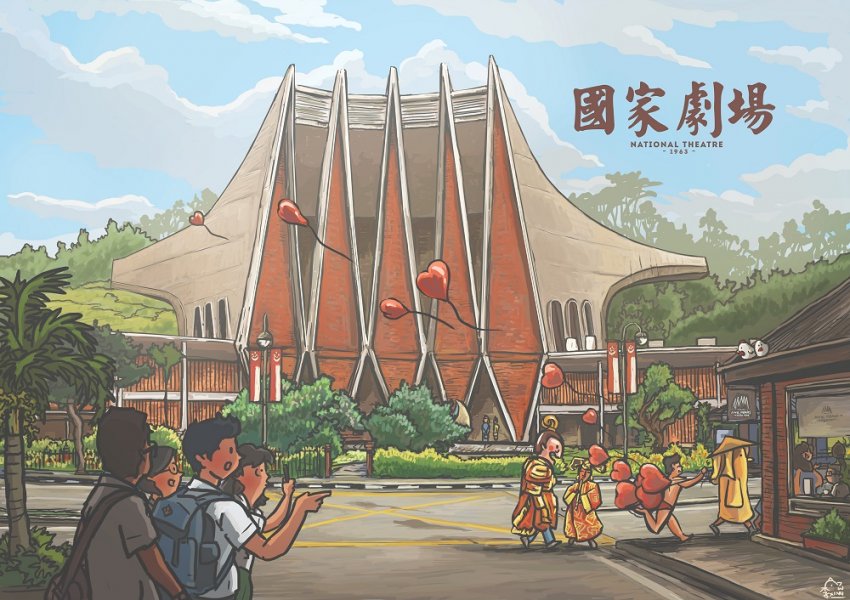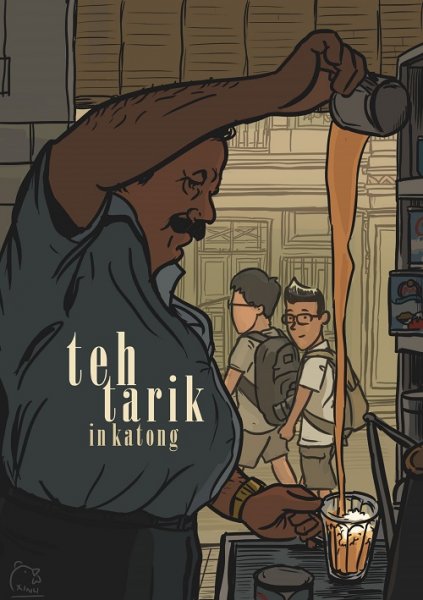This illustrator preserves memories of Singapore's ever-changing landscape
Lee Xin Li also thinks our obsessive nostalgia is an attempt to find our national identity.
You probably know architecture student and illustrator Lee Xin Li's famous kueh prints. But this year, he published Sayang Singapura, a collection of illustrations depicting Singapore's recently lost past. Combining the styles of Herge (of Tintin fame) and travel graphic novelist Guy Delisle along with archived photographs and personal memories of Singapore, his book shows the old Tanjong Pagar Railway Station, the old National Theatre and many other spots in a warm, personal light. Here he tells us more about the project and about Singapore's relationship with its past.

National Theatre, illustration by Lee Xin Li
What artists inspire your style?
There are many people whom I draw inspiration from. There is Georges Prosper Remi, otherwise known as Herge, the author behind the Adventures of Tin Tin comics, Studio Ghibli as well as Guy Delisle who rekindled my love for drawing and memory of Tintin comics.
Why this fascination of places that have been demolished?
It is more about re-visiting old memories and re-discovering Singapore in the process. Perhaps it is in part due to the architectural education and people I encounter, such as Dr. Lai Chee Kien, Dr. Yeo Kang Shua and Geraldene Lowe, who ignited an interest in Singapore’s changing landscapes. Illustration is my way of reflecting and recalling these memories like how others might have done in their own way like film, photography, poetry, journaling, et cetera. Collectively, it forms a repository of memories and references for the future generations to look into a past long out of reach like Lee Kip Lin’s photographs did for generations today.

Teh Tarik in Katong, illustration by Lee Xin Li
How do you draw places that have been demolished?
The photographs from Singapore Archives, PictureSG, old films, recollections by people, interviews, articles, newspapers, research papers, books, maps, et cetera provided useful references to construct a scene from these long-gone landscapes. Others which are more personal, such as Neo Tiew and Pulau Tekong, came from memory as well.

Neo Tiew, illustration by Lee Xin Li
Do you have any personal memories of any of them?
I have very fond memories of a number of them, one of which is Neo Tiew Estate in Lim Chu Kang. My dad used to drive my siblings and I to Neo Tiew to fetch my mum, who sold hor fun and chicken rice at the coffeeshop. My aunt and uncle also sold drinks there. We loved playing around the playground and wander about the estate. Today the estate is a military training ground. I went back there during my NS days for military training which was surreal because for one moment, we were defending the grounds of the former coffeeshop and clearing the rooms of my aunt’s former flat for imaginary enemies.

Adelphi Hotel, illustration by Lee Xin Li
Why do you think Singaporeans are so damn nostalgic?
To think that Singaporeans are simply yearning for the past is just not looking deeper. I don’t think it is just the unsettling pace of change in Singapore that resulted in nostalgia. Rather, nostalgia provided opportunities. Various entities propagate it for various intentions perhaps. Then there is also a common ground in nostalgia between the young and old. More importantly, I think partly nostalgia results from the deeper uncertainty or search for a national identity among Singaporeans. With a skyline largely attributed to foreign architects or more foreign presence, nostalgia is fuelled by a desire to dig deeper into Singapore’s past for what it means to be Singaporean, our histories, the kampong, food heritage, et cetera. Last but not least, one can not discount the role of social media in recent times which raised awareness of Singapore’s past and alternative historical narratives.

Soho Coffee, illustration by Lee Xin Li
Tell us about your book, Sayang Singapura.
I wept at the end of Kelvin Tong’s Grandma Positioning System in [recent SG50 omnibus] 7 Letters when grandma and the family members recounted many familiar landscapes that were sadly “bo liao” (gone)… I was confronted with the reality of loss of the landscapes which I grew up in and my loved ones whom I shared many memories in these lost landscapes such as Neo Tiew. Such sentiments served as the motivation for Sayang Singapura, which was published earlier this year. It is an expression of love for the home we grew up in yet at the same time pity for the loss. It is an imaginative journey of rediscovery of these landscapes that were lost or are soon to be gone.
Lee Xin Li's book, Sayang Singapura, is available via Cat Socrates, Kinokuniya, Times, MPH and Popular Bookstore. You can see more of his work here and here.
Advertisement